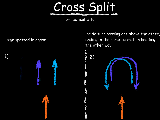Formation Flying
Keeping & Driving the formation
Formations:
Formation flying and fighting was a major issue in WWII. In
the begginig of the war, formations were tight as they were in WWI where visual
signaling was used among the pilots. The problem with tight formations is
that they require a lot of attention to maintain, instead of using it for
SA.
Most books I've read about early WWII air war, mention the fact
that both sides changed their formation tactics frequently, experimenting
with different approaches. Finally, the "pair" became the basic
tactical unit on both sides and still is in modern air war.
The "Spread" Formation:
The "modern" formation is the "spread" formation
or "line abreast".
In this formation, the pair flies side by side, and clear each other's dead
views:
<pic>
Also, the symmetry of it, enables both pilots to be defensive
or offensive as needed. As will be explained later, the spread of the pair
(distance) plays an important role in offensive and defensive situations and
should change according to the plane types and mission type.
As a rule of thumb, for "casual" flying around d500
is convenient to maintain, while when headed into the frey, distance should
grow up to about d1.0 .
Driving the "Spread" Formation:
Should the pair try to turn to another direction for more
than a few degrees, they would find themselves in a "line astern",
and the rear pilot would find it difficult to return to his position.
For this reason, "turning" as opposed to "course correction"
should be done using the "Tactical Turn".
Making a 180 degrees "in-place" turn, like in a bar-patrol should
be done using "Cross Split".
-
Section-leader start the turn by announcing the final
direction.
-
The "outside" pilot start turning first while
"inside" keep going straight.
-
when the "outside" pilots passes his 5oc (or
7 oc) "inside" pilot starts his turn.
-
End the turn in the announced direction and correct position
for "combat spread".
-
Click pic for a larger view of the blackboard:

-
Section leader announces a cross-split.
-
Both pilots turn "inside" simultaniously".
-
Passing one above the other, ending the turn in a "line
abreast formation" heading the other way.
-
If done against a chasing bandit, distance providing,
follow up with a "Bracket" attack.
-
Check the blackboard for visual description:

Flying a 4some:
A foursome formation is just two pairs formation and should
be treated as such.
The only difference is that in 4some the formation leader is calling the direction
and man settings (besides tactical orders).Again we do not want to be too
busy keeping the formation, so we fly "Pairs loose formation":

